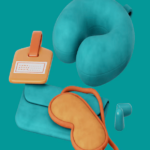Introduction
If you’ve ever sat down to meditate, you know that comfort and proper posture are key to a successful practice. Without the right support, it can be difficult to focus on your breath, let go of distractions, or even fully relax. This is where a Zafu meditation cushion comes in.
The Zafu, a round, typically firm cushion, plays an important role in supporting your body during seated meditation. By offering the right alignment and comfort, it helps you maintain a stable and pain-free posture, so you can concentrate on your practice without being distracted by discomfort. When choosing a Zafu cushion, it’s essential to consider a few key factors like material, shape, and filling—each of which plays a role in your comfort, alignment, and overall meditation experience.
In this guide, we’ll walk through what a Zafu meditation cushion is, why it’s important, and how to choose the right one to enhance your practice.
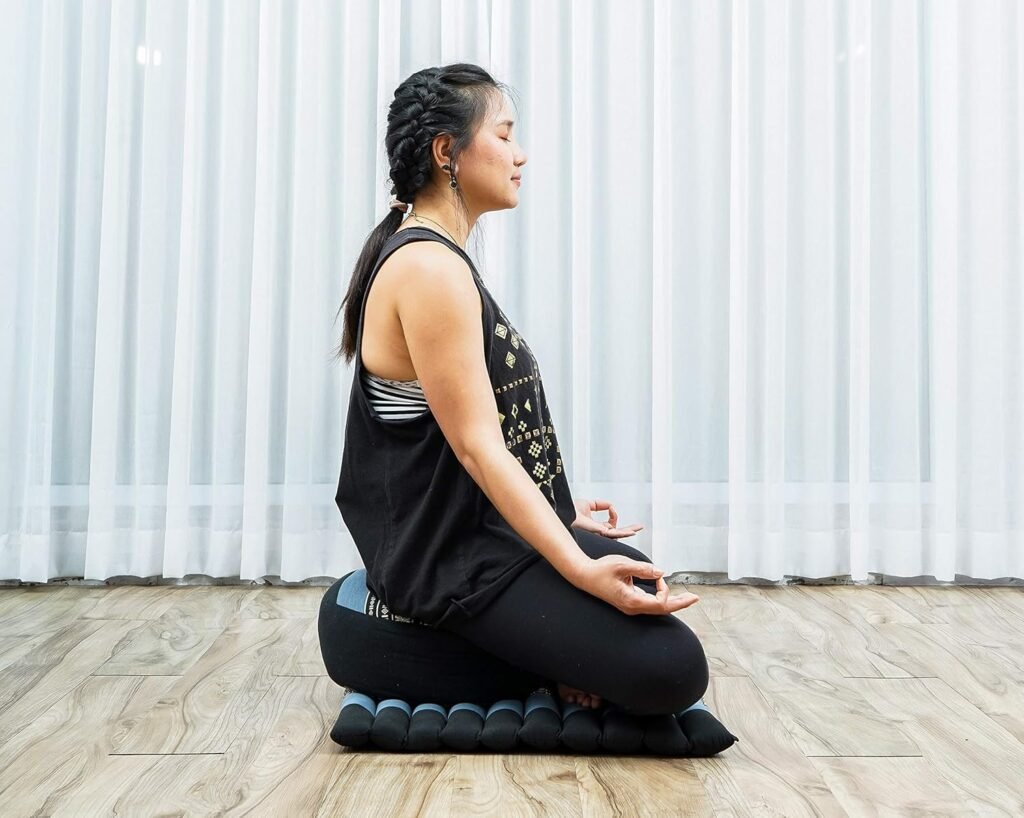
Understanding the Basics of a Zafu Meditation Cushion
Zafu Cushion Background
A Zafu is traditionally used in many types of meditation, particularly in Zen and Vipassana practices. The term “zafu” comes from the Japanese word for “cushion” and is often associated with sitting meditation, or zazen. While there are many different cushions for meditation, the zafu is one of the most common and time-tested designs.
Typically, a Zafu is round or crescent-shaped and offers support for the pelvis when seated cross-legged on the floor, such as in lotus or half-lotus postures. The cushion helps elevate the hips slightly above the knees, which not only helps relieve strain on the lower back but also encourages a more natural, stable posture.
Uses and Construction of a Zafu Cushion
Traditional Zafu cushions are filled with either buckwheat hulls or kapok fibers. Buckwheat hulls are a popular filling for their ability to mold to the shape of your body, providing both firmness and flexibility. Kapok, on the other hand, is a soft, lightweight, and eco-friendly filling option that offers more cushion and comfort.
The cushion’s cover is usually made from durable cotton, linen, or sometimes velvet for a more luxurious feel. Some Zafu cushions are even made with removable, washable covers for easy cleaning, which is essential for keeping your cushion fresh and hygienic.
The Physics of a Zafu Cushion
The design of the Zafu is centered around posture. When you sit on a zafu, the cushion raises your hips and tilts your pelvis forward slightly, promoting an ideal spinal alignment. This tilting effect encourages an upright posture, preventing slouching and supporting the natural curves of your spine.
This alignment helps reduce discomfort in the knees, back, and hips, making it easier to sit for extended periods of time without distraction. By giving you the proper support, the Zafu ensures that your body is in the best possible position to focus on your breath and stay mindful during meditation.
Benefits of a Zafu Meditation Cushion
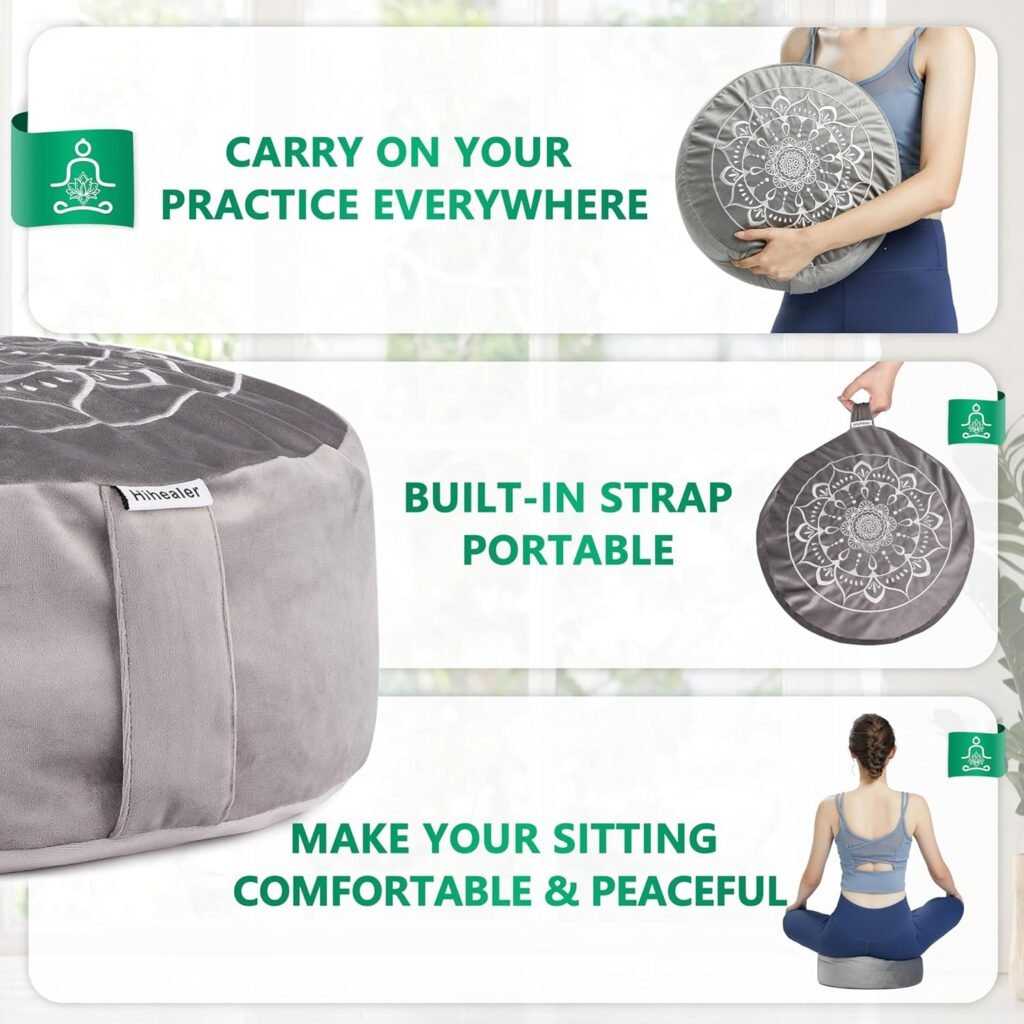
Choosing the right Zafu meditation cushion can bring a multitude of benefits to your practice. Here’s how:
1. Comfort
Meditation cushions aren’t just for sitting; they’re designed to enhance comfort while sitting in stillness for longer periods. A well-chosen Zafu helps reduce pressure points in areas like the hips and knees, allowing you to maintain a pain-free posture without having to adjust constantly.
2. Posture Improvement
The structure of the Zafu encourages better posture by tilting the pelvis and supporting your lower back. This promotes a more stable sitting position, allowing you to stay grounded and centered in your practice. Proper posture isn’t just about comfort—it also helps you breathe deeply and evenly, enhancing the quality of your meditation.
3. Enhanced Focus
A cushion that supports your body properly reduces distractions. If you’re not worried about discomfort or your body aching, your mind can more easily focus on the present moment. Over time, this can lead to more profound mindfulness and clarity in your practice.
4. Flexibility and Versatility
While a Zafu is ideal for seated meditation, its versatility extends beyond that. It can be used for yoga, stretching, or even as a supportive cushion for sitting at a desk or during informal relaxation. This flexibility means that your investment in a Zafu can serve multiple purposes, adding value to your practice and daily routine.
5. Mindfulness and Connection to Meditation Practice
The act of selecting a Zafu cushion can also deepen your mindful connection to your practice. As you choose the cushion that best meets your needs, you’re engaging in a mindful decision-making process, bringing a deeper sense of awareness to your environment and your meditation journey.
Types of Zafu Meditation Cushions
When choosing the right Zafu meditation cushion, it’s important to consider the shape, filling, and even the quality of the cushion. Each factor can affect your comfort, support, and overall experience during meditation. Let’s take a closer look at the different options available to help you make an informed choice.
1. Choosing the Right Zafu Shape
The shape of your Zafucushion is one of the first things to consider. It can directly influence how you feel during your meditation sessions. The two most common shapes for zafu cushions are round and crescent-shaped, each with its own set of benefits and potential drawbacks.
Round Zafu or Crescent Zafu?
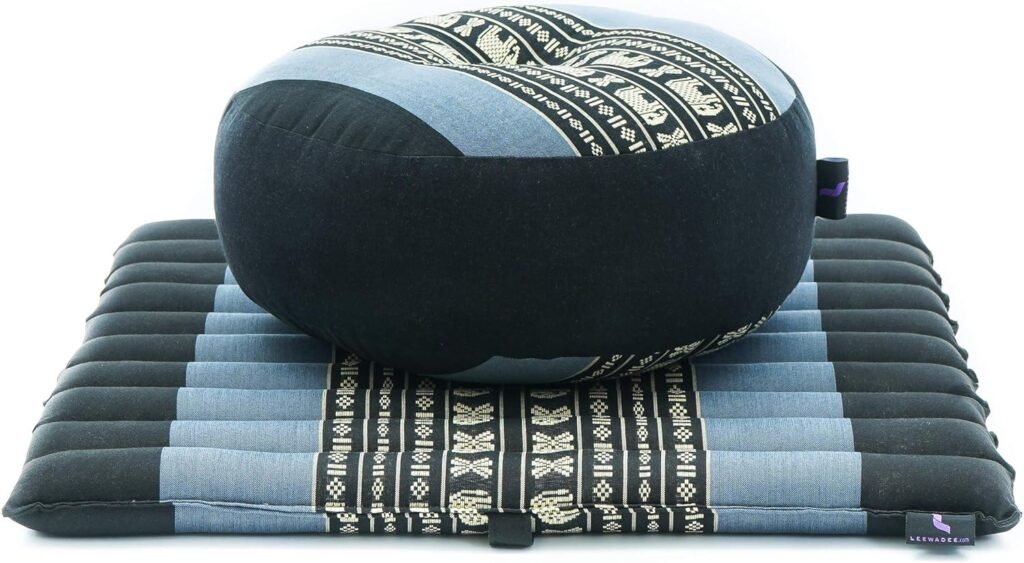
Round Zafu
This is the traditional Zafu cushion design. Its round shape allows you to sit cross-legged or in a lotus position, giving you a wide, stable base. The round shape is ideal for those who prefer a more neutral sitting posture, as it lifts the hips and slightly tilts the pelvis forward, promoting a naturally aligned spine.
- Pros:
- Perfect for sitting in classic meditation postures (lotus, half-lotus, or Burmese).
- Provides excellent support for the hips and pelvis.
- Versatile; can be used for a range of seated postures.
- Cons:
- May not provide as much targeted support for people with specific hip or back issues.
Crescent Zafu
The crescent-shaped cushion is designed to provide more specific support for your legs and lower back. It’s particularly beneficial if you have issues with your knees or hips, as the shape of the cushion helps prevent strain by providing a slight incline for the pelvis.
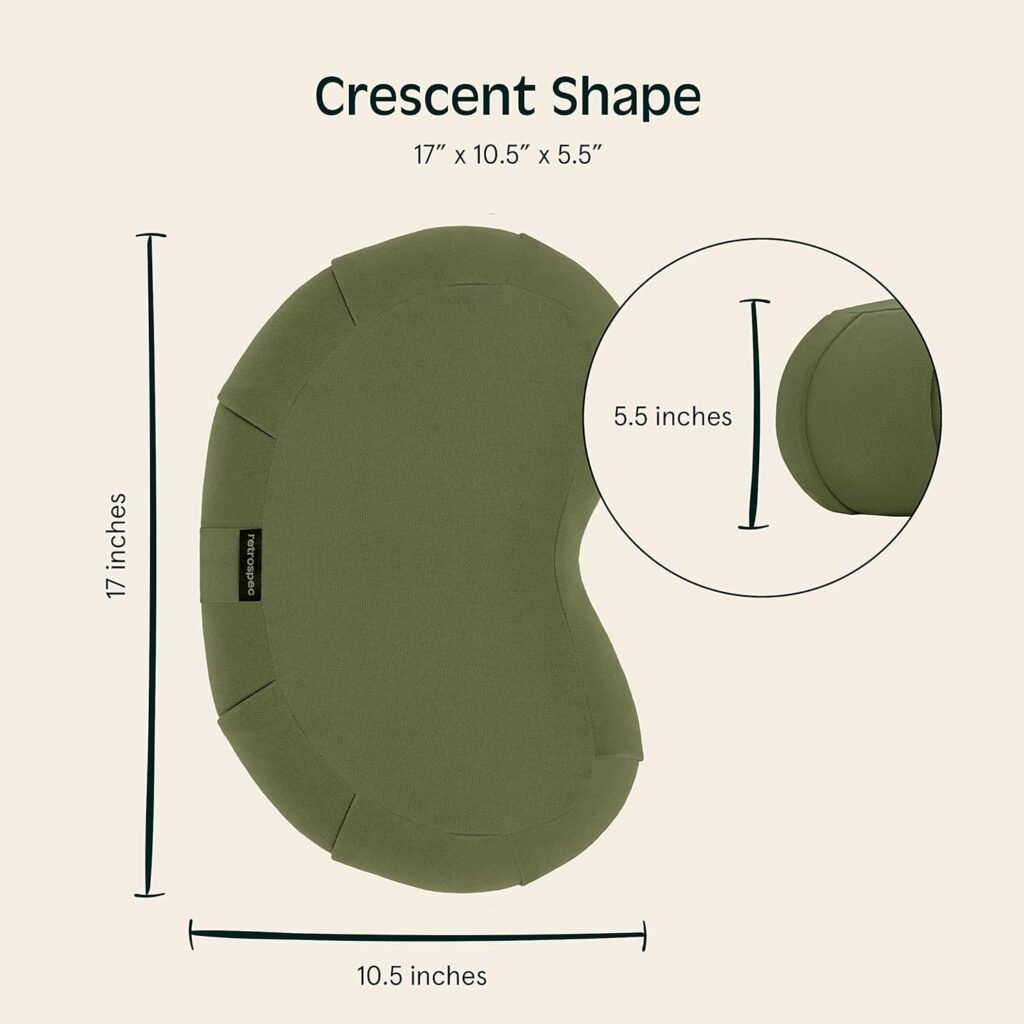
- Pros:
- Great for people who experience discomfort in their knees or lower back.
- The crescent shape can help keep the spine in alignment for a more comfortable seated position.
- Cons:
- May not be as versatile as the round Zafu for different sitting postures.
- Might feel less “traditional” for those who prefer the standard round cushion.
Ultimately, the shape you choose comes down to personal preference and body type. If you have flexibility or joint concerns, you may find the crescent shape more comfortable. On the other hand, if you’re accustomed to traditional meditation postures, the round Zafu will likely serve you well.
2. Choosing the Right Zafu Filling
The material used to fill your Zafu cushion plays a major role in how the cushion feels during meditation. Two common fillings are buckwheat hulls and kapok, each with its own set of advantages.
Buckwheat Hulls
Buckwheat hulls are the most traditional filling used inZafu cushions. These hard, triangular-shaped hulls mold to the shape of your body, offering firm support while allowing some flexibility. This filling is ideal if you’re looking for a cushion that offers more stability and structure.

Advantages of Buckwheat Hulls:
Firm Support: Buckwheat provides a firm yet flexible cushion that helps maintain proper posture.
Breathable: The hulls are naturally breathable, which helps keep the cushion cool and comfortable over long periods.
Durability: Buckwheat hulls can last a long time with proper care and won’t flatten easily.
Kapok
Kapok is a natural fiber obtained from the seed pods of the kapok tree. It’s lighter, softer, and more buoyant than buckwheat, making it a great choice for those seeking a softer, more cushiony feel during meditation.
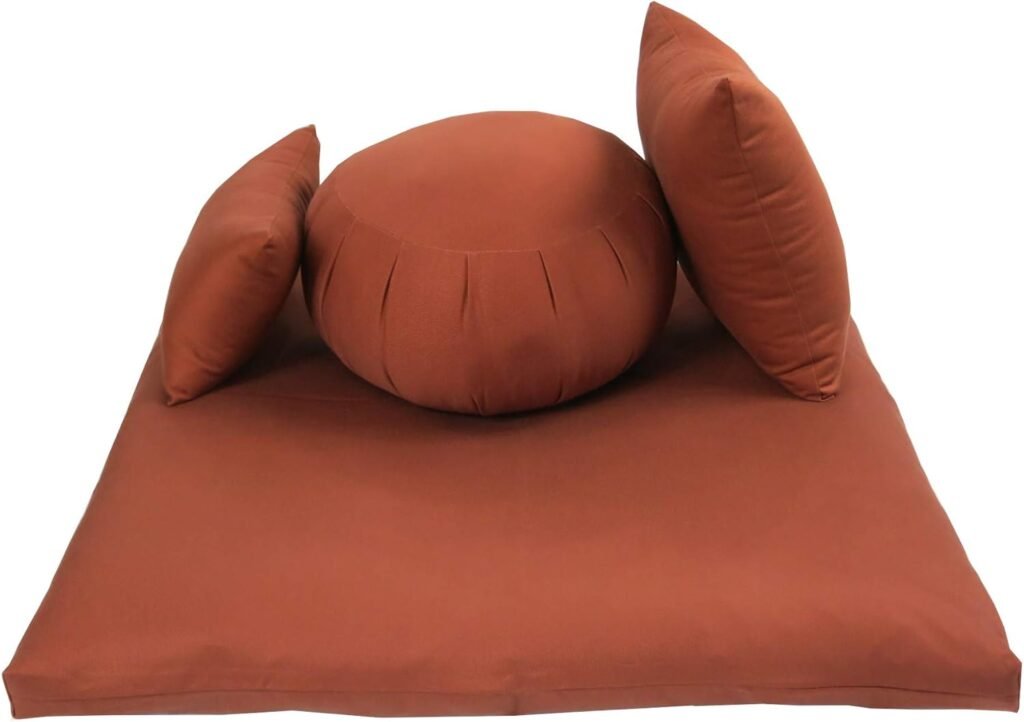
What is Kapok?
Kapok is a silky, fluffy fiber that comes from the kapok tree found in tropical regions. The fibers are extremely lightweight and have a natural buoyancy that makes them ideal for creating a cushion that provides a soft, comforting support. Although it’s not as firm as buckwheat, kapok still helps maintain good posture while offering a softer, less rigid meditation experience.
Benefits of Kapok:
- Soft and Light: Kapok provides a plush, soft experience, perfect for those who prefer a gentler support.
- Eco-Friendly: Since kapok is a natural, renewable resource, it’s a great choice for environmentally-conscious consumers.
- Temperature Regulation: Kapok naturally wicks away moisture, helping keep you comfortable during longer meditation sessions.
3. Standard vs. Deluxe Zafu Cushions
Once you’ve decided on the shape and filling, you’ll also want to consider the overall quality of the cushion. Zafu cushions come in two general categories: standard and deluxe. The differences between these cushions often come down to materials, durability, and ease of care.
Standard Zafu Meditation Cushion
Standard Zafu cushions are typically more affordable and straightforward in design. These cushions are often made with durable cotton covers and either buckwheat or kapok filling. They provide the basic support you need for your meditation practice without any extra frills.
- Overview: Simple, cost-effective, and functional.
- Cost: Generally more affordable compared to deluxe options.
- Use: Great for those on a budget or who are just starting out with meditation.
Deluxe Cushions with Removable Covers
DeluxeZafu cushions are made from higher-quality materials and often come with removable, washable covers for easy cleaning. Some deluxe options also feature additional padding, better stitching, or more luxurious fabric like velvet or organic cotton.
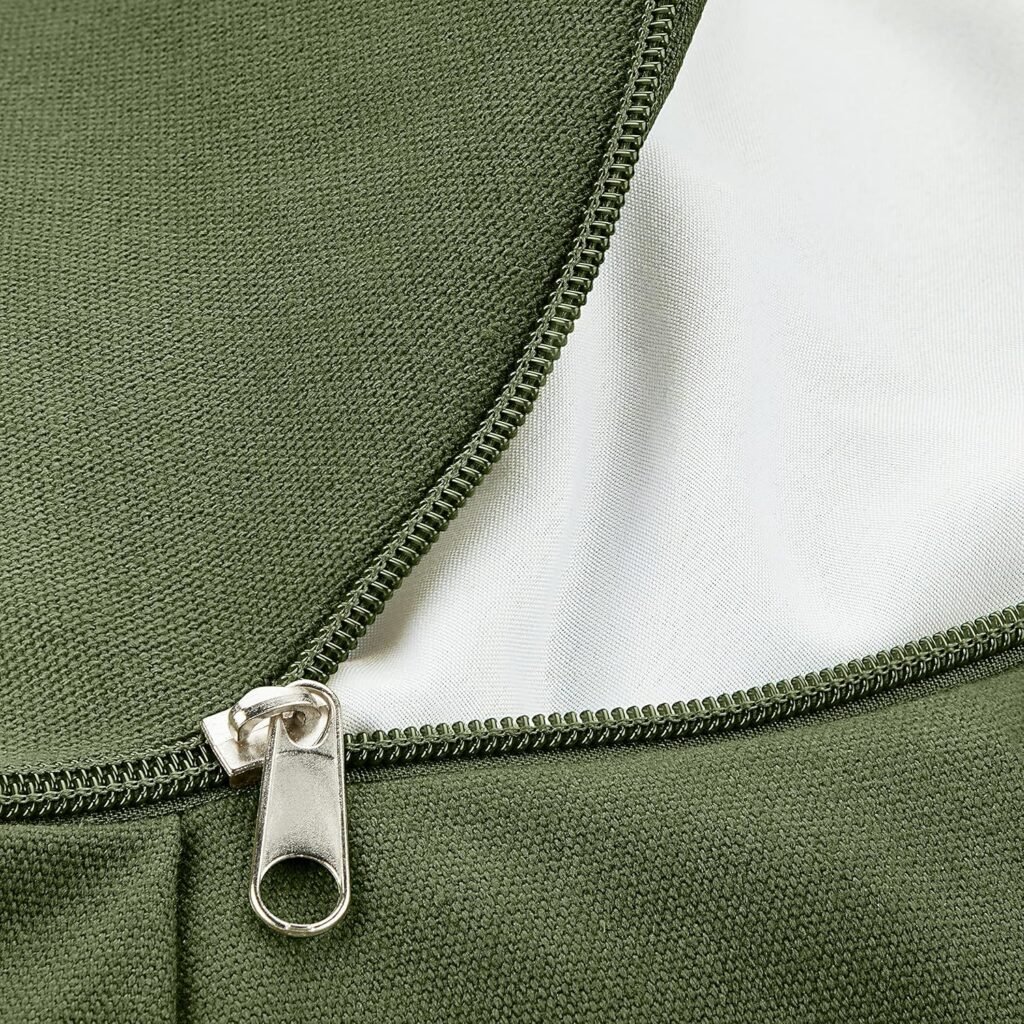
- Benefits:
- Easy to Clean: Removable covers make washing the cushion easier, keeping it hygienic over time.
- Durability: Deluxe cushions are often made with more durable materials, meaning they’ll last longer with proper care.
- Comfort: Many deluxe cushions are designed with extra cushioning or better filling for enhanced comfort during meditation.
Proper Care for Your Zafu Meditation Cushion
Taking care of your Zafu cushion is essential to maintaining its comfort and extending its lifespan. Here’s how to keep your cushion in top shape for years to come.
Basic Zafu Care and Maintenance
Like any piece of furniture or accessory, your Zafu will benefit from regular care. Keeping your cushion clean and well-maintained will ensure it continues to support you throughout your meditation practice. Here’s how to care for your zafu:
Regular Care Tips for a Zafu Meditation Cushion
Spot Cleaning:
If your cushion gets dirty or develops minor stains, use a soft cloth and mild soap to spot clean the area. Avoid soaking the cushion in water, as this can affect the filling material, especially if it’s filled with buckwheat hulls or kapok.
Proper Handling and Storage:
When not in use, store your cushion in a dry, cool place away from direct sunlight to prevent any potential fading or damage to the fabric. It’s also important to store it in a place where it won’t get crushed or lose its shape.
Rotating and Fluffing:
To avoid uneven wear, rotate your Zafu regularly. Fluffing the cushion helps redistribute the filling, keeping it comfortable and supportive for longer periods.
Extending the Life of Your Zafu Meditation Cushion
For long-lasting use, consider investing in a cushion with a removable cover that can be washed regularly. If your cushion is filled with buckwheat hulls, consider replacing the filling every 2–3 years, as it can settle and lose its firmness over time. For kapok-filled cushions, make sure the fibers are fluffed periodically to maintain their comfort level.
Special Care Instructions for Meditation Cushions and Accessories
Meditation cushions are essential tools for creating a comfortable and supportive environment for your practice. Proper care and maintenance ensure that your cushion lasts for years and continues to provide the support you need. In this section, we’ll explore how to care for different types of meditation cushions and other accessories to keep them in top shape.
Care Instructions for Various Types of Meditation Cushions
Different types of meditation cushions require specific care to maintain their form and functionality. Here’s a breakdown of how to care for the most common types.
Standard Cushions (Zafus, Zabutons, Supports, Bench Cushions)
Standard meditation cushions such as Zafus, zabutons, support cushions, and bench cushions are usually made from sturdy materials like cotton or linen and filled with buckwheat, kapok, or synthetic fibers. They need regular care to keep them clean and comfortable.
- Spot Cleaning: For minor stains, use a mild detergent and warm water to spot clean. Be gentle to avoid damaging the fabric or filling.
- Fluffing and Rotating: Regularly fluff the cushion to prevent the filling from settling. Rotating the cushion helps evenly distribute wear.
- Storage: Store your cushions in a dry, cool place when not in use. Avoid direct sunlight to prevent fading or deterioration of the fabric.
Deluxe Cushions with Removable Covers
Deluxe Zafucushions with removable covers are designed for easier cleaning and maintenance. They tend to be made from high-quality fabrics, and their filling materials may include buckwheat hulls, kapok, or even memory foam.
Washing the Cover:
Always check the care instructions on the tag of your cushion cover. Most removable covers can be machine-washed, but use a gentle cycle and cold water to preserve the fabric. Air-dry the cover instead of using a dryer to prevent shrinkage.
Fluffing the Filling:
If your cushion is filled with natural materials like buckwheat or kapok, you’ll need to occasionally fluff the filling to maintain comfort and support.
Tibetan Seats and Nomad Benches
Tibetan-style seats and nomad benches are often used for meditation in specific cultural contexts. These cushions typically feature a low, firm structure that supports the spine and hips during long meditation sessions.
Regular Maintenance:
These types of cushions are often made with materials such as wool, cotton, or organic hemp. Clean them by gently brushing off dust or dirt and spot clean with a damp cloth if necessary.
- Storing:
To maintain the structure and appearance, avoid folding or squishing these cushions when not in use. Store them flat in a dry, cool place.
Caring for Meditation Accessories
Aside from cushions, there are other meditation accessories that need proper care to ensure they last and continue to serve their purpose. Two common accessories are Samue clothing and Oryoki sets.
Samue Clothing
Samue clothing is traditional Japanese meditation attire designed for comfort during seated practices.
- Washing: Samue clothing is typically made of cotton or linen. Wash your Samue with gentle detergent in cold water to prevent shrinking and preserve the fabric’s softness.
- Storage: Hang your Samue in a well-ventilated space to avoid musty odors. Avoid direct sunlight for long periods, as it can cause fading.
Oryoki Sets
Oryoki sets are traditional Japanese sets used during meals in meditation retreats. These sets include bowls, chopsticks, and cloths for covering and cleaning the items.
Cleaning:
Wash Oryoki items by hand with mild soap and warm water. Be sure to dry them thoroughly before storing them in a dry, cool place to prevent any moisture-related damage.
Proper Positioning When Using a Zafu Meditation Cushion
The effectiveness of your meditation practice depends largely on your posture. A Zafu cushion is designed to help you sit comfortably, but positioning it correctly is essential to maintain proper alignment and support. Let’s take a look at how to position your zafu cushion for maximum benefit.
Finding the Optimal Sitting Position
When using a Zafu cushion, the goal is to maintain a relaxed yet aligned posture. Here are some tips to achieve the best sitting position:
Sitting Cross-Legged:
Sit with your legs crossed, ideally in the lotus or half-lotus position. The Zafu will lift your hips slightly above your knees, helping to keep your spine straight and preventing slouching.
Knees on the Ground:
Ensure that your knees are touching the floor or mat. If you feel strain in your knees, consider adjusting the height of your Zafu or using a zabuton underneath for additional support.
Using a Zafu and Zabuton Set
A zabuton is a flat cushion placed underneath your Zafu. This combination enhances your comfort and support, especially for longer meditation sessions.
How It Complements the Zafu:
The zabuton provides cushioning for your knees, ankles, and lower back, helping to prevent discomfort from sitting on hard floors. Together, the Zafu and zabuton help create an optimal meditation posture.
How to Set Up the Set:
Place the zabuton on the floor first, ensuring it’s positioned to give support to your lower legs. Then place your Zafu on top of the zabuton, ensuring it’s aligned to support your hips and spine.
Adjusting the Zafu for Various Postures
While Zafus are traditionally used for seated meditation, they can also be adapted for other postures:
- Kneeling: If you prefer kneeling during meditation, you can place the Zafu under your knees for extra cushioning.
- Cross-Legged: For classic cross-legged positions, ensure the Zafu is high enough to elevate your hips, providing natural pelvic alignment.
FAQs
Do I need a Zafu/Zabuton set to start meditating?
No, a Zafu and Zabuton set isn’t essential to start meditating, but they can significantly enhance your comfort and posture. You can begin with a simple cushion or mat, and as your practice deepens, consider investing in a zafu and zabuton set for added support.
What makes a good Zafu meditation cushion?
A good Zafu cushion should provide adequate support for your hips and spine while being comfortable enough for extended periods of sitting. Look for a cushion made from durable, breathable materials and consider your preferred filling—buckwheat hulls for firm support or kapok for a softer feel.
How often should I replace my Zafu cushion?
The lifespan of a Zafu cushion depends on the materials used and how often it’s used. Generally, a Zafu cushion can last 2-3 years if maintained well. If the filling starts to flatten or the fabric begins to wear, it’s time to consider replacing it.
Is kapok or buckwheat hull filling better for beginners?
For beginners, kapok might be a better choice as it offers a softer, more forgiving feel, which can be more comfortable if you’re new to seated meditation. However, if you prefer more firm support, buckwheat hulls will provide better stability.
How can a zafu cushion enhance my meditation experience?
A Zafu cushion helps by aligning your spine, supporting your hips, and reducing discomfort during long meditation sessions. This physical support can make it easier to focus on your breath and maintain mindfulness without being distracted by pain or discomfort.
Conclusion: Enhancing Your Meditation Practice with the Right Zafu Meditation Cushion
Choosing the right Zafu meditation cushion is essential for creating a comfortable, supportive environment for your practice. The proper cushion helps improve your posture, alignment, and comfort, which in turn allows you to stay focused and deepen your meditation experience. Whether you opt for a traditional round zafu, a deluxe cushion with a removable cover, or the softer kapok-filled cushion, make sure you select one that suits your body type, preferred sitting posture, and comfort level.
By properly caring for your Zafu cushion and other meditation accessories, you can ensure they last for years, continuing to support your practice and contribute to your overall mindfulness journey. Take time to explore your options, experiment with different shapes and fillings, and make adjustments to find what works best for you.
Share Your Thoughts and Experiences!
We’d love to hear about your journey with meditation cushions! Whether you’re a seasoned meditator or just starting out, your experience can help others find the perfect cushion for their practice. Have you tried different types of Zafu cushions or experimented with different fillings? What made the biggest difference for your comfort and posture?
Feel free to share your thoughts, tips, or any questions in the comments below! Your feedback not only helps us improve our content but also fosters a community of mindful practitioners who can learn from each other.
If you found this article helpful, don’t forget to share it with friends, family, or fellow meditators. The more people who discover the benefits of the right meditation cushion, the better!
May Like to Explore More:
Meditation Pillows Anti-Allergy Pillows Aromatherapy Pillows
Bamboo Pillow Natural Latex Pillows Organic Cotton Pillows Recycled Material Pillows


